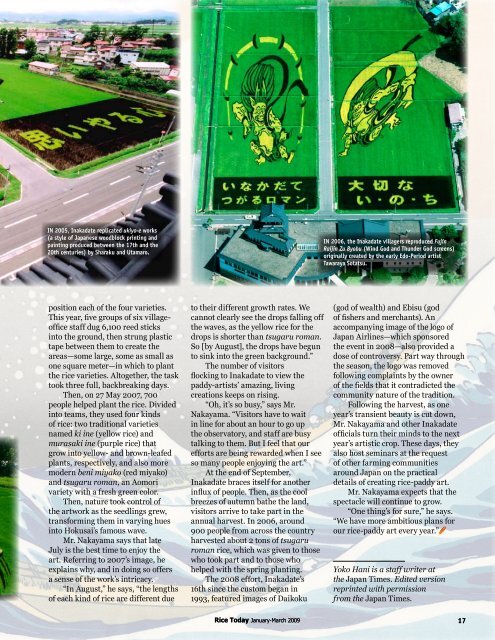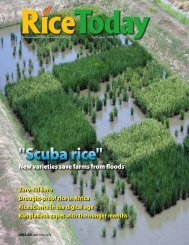In 2005, Inakadate replicated ukiyo-e works(a style of Japanese woodblock printing andpainting produced between the 17th and the20th centuries) by Sharaku and Utamaro.In 2006, the Inakadate villagers reproduced FujinRaijin Zu Byobu (Wind God and Thunder God screens)originally created by the early Edo-Period artistTawaraya Sotatsu.position each of the four varieties.This year, five groups of six villageofficestaff dug 6,100 reed sticksinto the ground, then strung plastictape between them to create theareas—some large, some as small asone square meter—in which to plantthe <strong>rice</strong> varieties. Altogether, the tasktook three full, backbreaking days.Then, on 27 May 2007, 700people helped plant the <strong>rice</strong>. Dividedinto teams, they used four kindsof <strong>rice</strong>: two traditional varietiesnamed ki ine (yellow <strong>rice</strong>) andmurasaki ine (purple <strong>rice</strong>) thatgrow into yellow- and brown-leafedplants, respectively, and also moremodern beni miyako (red miyako)and tsugaru roman, an Aomorivariety with a fresh green color.Then, nature took control ofthe artwork as the seedlings grew,transforming them in varying huesinto Hokusai’s famous wave.Mr. Nakayama says that lateJuly is the best time to enjoy theart. Referring to 2007’s image, heexplains why, and in doing so offersa sense of the work’s intricacy.“In August,” he says, “the lengthsof each kind of <strong>rice</strong> are different dueto their different growth rates. Wecannot clearly see the drops falling offthe waves, as the yellow <strong>rice</strong> for thedrops is shorter than tsugaru roman.So [by August], the drops have begunto sink into the green background.”The number of visitorsflocking to Inakadate to view thepaddy-artists’ amazing, livingcreations keeps on rising.“Oh, it’s so busy,” says Mr.Nakayama. “Visitors have to waitin line for about an hour to go upthe observatory, and staff are busytalking to them. But I feel that ourefforts are being rewarded when I seeso many people enjoying the art.”At the end of September,Inakadate braces itself for anotherinflux of people. Then, as the coolbreezes of autumn bathe the land,visitors arrive to take part in theannual harvest. In 2006, around900 people from across the countryharvested about 2 tons of tsugaruroman <strong>rice</strong>, which was given to thosewho took part and to those whohelped with the spring planting.The 2008 effort, Inakadate’s16th since the custom began in1993, featured images of Daikoku(god of wealth) and Ebisu (godof fishers and merchants). Anaccompanying image of the logo ofJapan Airlines—which sponsoredthe event in 2008—also provided adose of controversy. Part way throughthe season, the logo was removedfollowing complaints by the ownerof the fields that it contradicted thecommunity nature of the tradition.Following the harvest, as oneyear’s transient beauty is cut down,Mr. Nakayama and other Inakadateofficials turn their minds to the nextyear’s artistic crop. These days, theyalso host seminars at the requestof other farming communitiesaround Japan on the practicaldetails of creating <strong>rice</strong>-paddy art.Mr. Nakayama expects that thespectacle will continue to grow.“One thing’s for sure,” he says.“We have more ambitious plans forour <strong>rice</strong>-paddy art every year.”Yoko Hani is a staff writer atthe Japan Times. Edited versionreprinted with permissionfrom the Japan Times.Rice Today January-March 2009 17
Rice on theby Yothin Konbooncutting edgeSometimes the best inventions are accidental. In northeastern Thailand, farmersare adopting a weed-control method first taught to them by their animals.yothin konboonIf performed correctly, thepractice of planting <strong>rice</strong> bybroadcasting <strong>rice</strong> seeds directlyinto unflooded soil offersseveral advantages over the usualpractice of transplanting seedlingsinto flooded fields. Farmers can savetime and labor, less <strong>water</strong> is requiredto establish the crop, and dry directseeded<strong>rice</strong> suffers less from earlyseasondrought. These are importantadvantages, especially in rainfed <strong>rice</strong>,and dry direct seeding is gainingpopularity in a number of areasacross Asia. According to the ThaiOffice of Agricultural Economics,around 38% of rainfed <strong>rice</strong> (reliant onrain with no irrigation infrastructure)in northeasternThailand in 2005was planted todry directseeded<strong>rice</strong>, andthis figure isgrowing.The main problem withdirect-seeded <strong>rice</strong> is weed control.Transplanting seedlings gives <strong>rice</strong>a head start over weeds, and acontinuous layer of <strong>water</strong> suppressesweed growth. In northeasternThailand, the methods used tocontrol weeds differ from placeto place. Some farmers followofficial agriculture departmentrecommendations while othersdevelop their own methods.One of the most promisingfarmer-initiated controls is <strong>rice</strong>cutting, a method first studied in1998 in deep<strong>water</strong> <strong>rice</strong> by Thairesearcher Tawee Kuptkarnjanakul.Because deep<strong>water</strong> <strong>rice</strong> is plantedvery early in the season, the periodbefore flowering is long, resultingin excess growth of leaves andshoots. Farmers would cut theleaves just above the <strong>water</strong> surfaceprimarily to use as animal feed.In northeastern Thailand, <strong>rice</strong>cutting began around 10 years ago,but not as a result of transfer fromdeep<strong>water</strong> <strong>rice</strong> systems. Early-seasondrought is a regular occurrence inthe region and direct-seeded cropsfrequently suffer. When this occurs,some farmers give up on theircrop, leaving it for their animalsto graze. Over the years, farmersCUTTING RICE with aswing grass mower canhelp control weeds.have discovered that, when therains finally resume, the grazedcrop recovers well and ends upyielding a reasonable harvest.After a few years of trial anderror, farmers in different areasdeveloped their own <strong>rice</strong>-cuttingmethods, which all include cuttingdown weeds as well as <strong>rice</strong> earlyin the season. In some places,cutting is done primarily to reduceweed competition; in others, itis to improve soil fertility. Thepractice is spreading throughfarmer-to-farmer communication,media campaigns, and extensionworkers (the people responsiblefor technology dissemination).<strong>How</strong>ever, farmers’ and researchers’understanding of the benefits of <strong>rice</strong>cutting, and the conditions underwhich it succeeds or fails, is stillvery limited. Therefore, Thailand’sUbon Ratchathani Rice ResearchCenter (URRC)—with assistancefrom the Consortium for UnfavorableRice Environments (CURE), agroup of national and internationalinstitutions led by the InternationalRice Research Institute—ha<strong>sr</strong>ecently conducted farm surveysto study and test this technology.Farmers who practice <strong>rice</strong> cuttingsay that it boosts their <strong>rice</strong> yieldssubstantially, with some claimingthat it also improves soil fertility.They tend to use the method withtall, photosensitive <strong>rice</strong> varieties—that is, varieties that flower inOctober independent of the sowingdate—including Thailand’s famousjasmine <strong>rice</strong>. Once the <strong>rice</strong> crop hasbeen established, it is managed asusual until late July–early Augustwhen the <strong>rice</strong> cutting is conducted.This leaves around 50 days before18 Rice Today January-March 2009

















